Rob Gregor, a professional bus painter with the Port Botany depot of the State Transit Authority of NSW, took some long service leave and began work.
Thanks to the good offices of the Sydney Tram Museum at Loftus, the work is being carried out in an annexe to their workshops, where there is space to erect scaffolds for access to the high up panels, and a well-lit area. Unfortunately it was soon found to be a very dusty area, and the first items to receive paint, some interior pillar covers, showed fearful dust contamination after sitting to dry. So with my trusty aide Craig Parkinson, we moved the bus outside, washed it down and then hosed out the interior of the annexe, which exorcised the demon dust. Next step was to acquire some undercoat to mix 50/50 with colour to make a first coat. And a large quantity of Prepsol, to remove wax and grease and dirt from the surfaces to be painted.
A first try at full painting of a test panel was not very encouraging, as there were very visible brush marks in the final finish. The rear of the same panel was cleaned up and at the second try the result was satisfactory.

ROB, THE BUS, THE ANNEXE AND THE SECOND TEST PANEL SHOWING THE FINAL RED OF THE MAIN PANELS OF THE BUS.
Not seen are about 100 small items of mainly interior trim, pillar covers, advertisement racks, window trims, etc. painted in the brown paint from Scotland, called Nussbraun, "Nut Brown"; I believe the paint was made in Holland, and sent out to me at great expense in freight by my friend Paul Adams of Albion restoration fame (see links: Restoring a Sydney Albion).
However it is beautiful paint which flows out perfectly, leaving no brush marks and dries not too quickly, so there is time to 'lay off': ie do a series of smooth downward brush strokes with a very broad brush to remove excess paint and leave the painted surface evenly coated. Thinking about it, I think it's bit like the difference between Belgian chocolate and some others: the consistency is incredibly smooth, achieved by microfining the particles of colour.
There is a another dimension to the bus' presence at Loftus. Tuesday September 19th is the occasion of the launch of a book by John Dunn, a history of Comeng (Commonwealth Engineering) which in a previous incarnation was Waddington's Ltd, builders of the body of this bus. The speaker will be ex-MP Tim Fischer, and the bus will be a fine example of a pre-war Waddington body. The book is available from the bookshops of both Sydney Tramway Museum and Sydney Bus Museum, at $59-95 plus postage. It is lavishly illustrated with cars, buses, railway carriages and locomotives, steam and diesel, by Commonwealth and its predecessors.

IN THE BELIEF THAT PAINTING WOULD HAVE BEEN DONE AT LEAST 18 MONTHS AGO, I HAD STRIPPED THE ROOF OF ALL PAINT AND LEFT IT BARE. Unfortunately the metal strips covering the joints between the aluminium roof panels are steel, and they had a heavy film of rust on them, so Rob is seen here coating them with metal primer. The gutter visible here was full of dust and has been vacuumed clean.

THE SAME SCENE, WHERE ROB HAS PROGRESSED TO THE REAR OF THE ROOF WHICH HAS BEEN CLEANED ALL OVER WITH PREPSOL TO REMOVE DIRT, WAX AND GREASE.
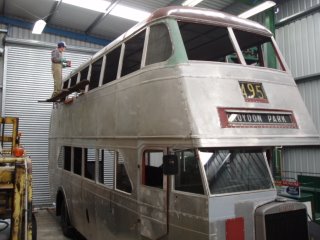
SYDNEY HAD JUST HAD A WEEK OF VERY HEAVY RAIN; ABOUT 5 INCHES HAD FALLEN TO EVERYBODY'S RELIEF, AND IT FINED UP JUST AS OUR PAINT JOB BEGAN. If not, drying of the gloss paint could have been affected. Here Rob begins the job of applying a mix of 50/50 undercoat and gloss brown to the roof.
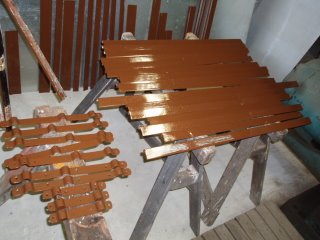
Some of the hundred or so small items of interior trim in brown: the ones on the left hold safety rails along the nearside top deck windows. The DRTT got sick of passengers losing arms and heads by leaning out as the bus passed a shop awning or tree.

The distinctive "Camperdown" arched entry to the lower deck saloon. Very soon after this bus, the entry became rectangular with heavy angled braces at each side.

The ceiling in the lower deck has received its undercoat and first colour coat. Sept. 18th.

Rob applies cream 50/50 undercoat to the lower saloon entry: from this point inwards the ceiling is white.
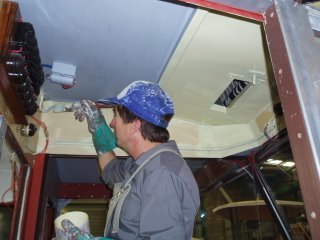
Rob squeezes into the driver's cab (minus the seat) to apply cream undercoat to the ceiling and pillars.
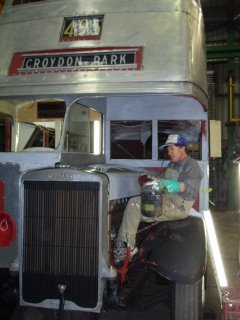
The ceiling over the engine bay is also cream, including the engine top cover and some of the bulkhead behind the autovac.

A view from the mezzanine floor in the main workshop, where the bus has been moved for the Comeng book launch on September 19th. The roof has had its colour coat.

THE REAR PLATFORM has acquired its final colour coats, but not the lining out in black between colours. Visible here are: LTE bus red, Nussbraun, and British Standard Colour 352, pale cream. The latter two were supplied with much effort and persistence by my dear friend Paul Adams in Paisley. The red had been acquired by David Wilson for use on the London RT bus and other Sydney pre-war buses at Tempe Museum.
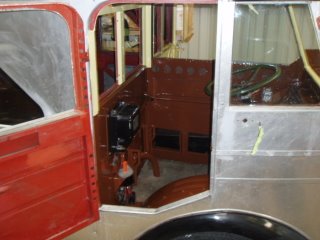
THE DRIVERS CAB IN FINAL COLOUR: the door has yet to be done , also in brown around the frame. The complexities of the colour layout can be seen: I have had to use post-war buses as the pattern for this, in the absence of any early photos of 1930s bus interiors. Here's hoping......
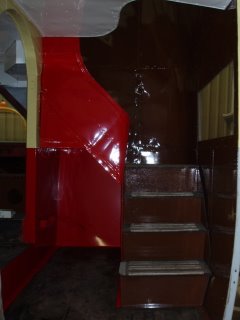
The stair well, in brown, with the red putting in an appearance on the stair valance (?) Is that what one calls it?

By the afternoon of September 23rd really visible action had begun. Back in the annex, somewhat freer of the dust problem, undercoating of the broad surfaces on the top deck began. Rob Gregor is seen, on the rather safer hydraulic scissor lift, applying a first coat of 50/50 white undercoat and red. The cream around the windows has been done. Rule 1: start at the top and work down.
No comments:
Post a Comment